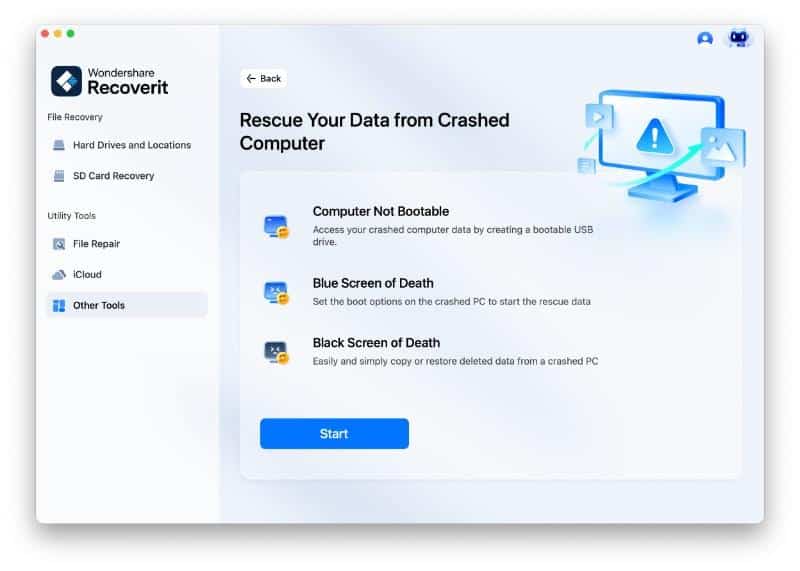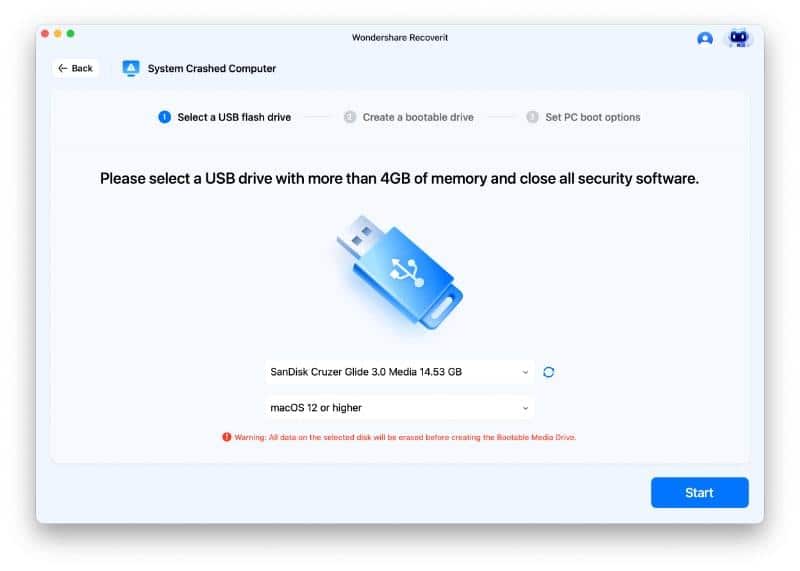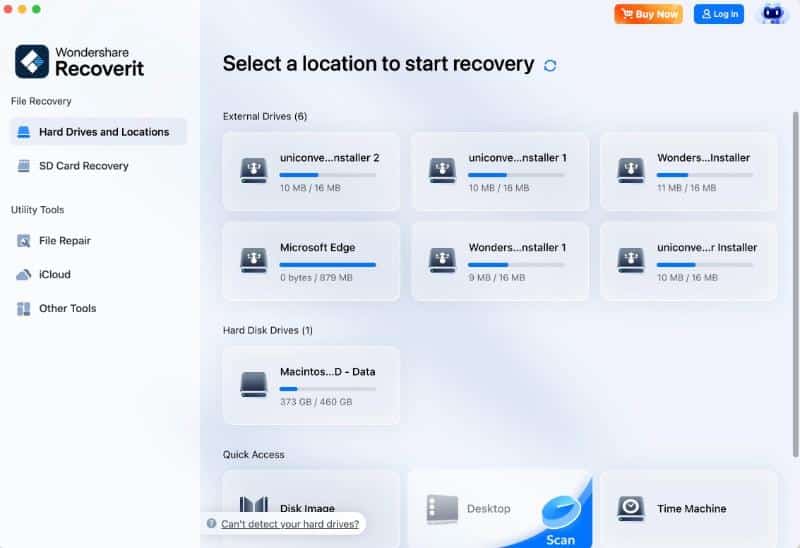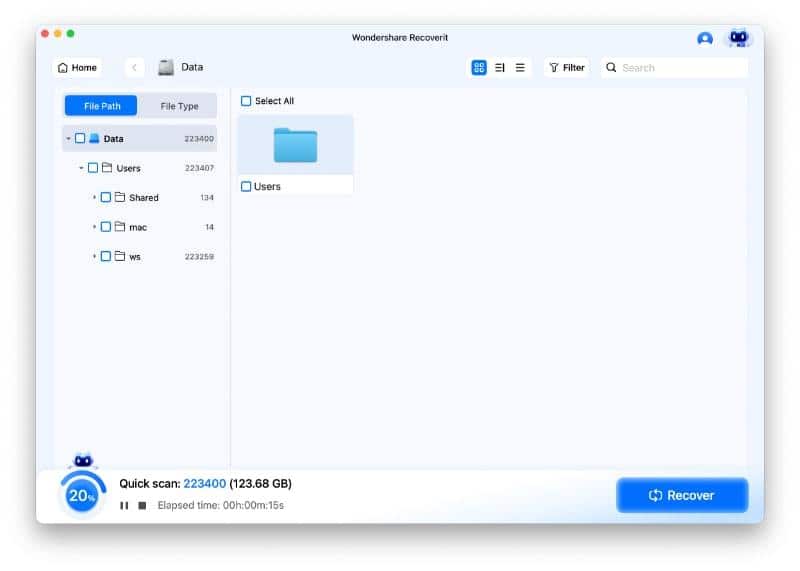Introduction: Your Data is Safe, Even If Your Mac Isn’t
If your Mac won’t start—showing a blank screen, a flashing folder, or a stuck loading bar—your first worry is probably about your files. The good news is, your photos, documents, and other data are likely still safe on the hard drive. The problem is usually with the software, not your files.
To get them back, you have two main options: using macOS’s built-in Recovery Mode, or starting up from an external drive. Both methods can help you recover your important data from a Mac that won’t boot.
Method 1: The Ultimate Solution – Bootable Data Recovery Media
When Recovery Mode fails or your Mac shows no response to startup commands, bootable data recovery media becomes your most powerful option. This method runs Mac data recovery software from external sources, completely bypassing your Mac’s damaged operating system.
Creating Bootable USB with Wondershare Recoverit:
Wondershare Recoverit‘s “System Crashed Computer” feature creates specialized bootable media that can start non-functional Macs and recover data directly from internal storage.
Step-by-Step Creation Process:
Step 1: Prepare Working Computer
- Use another Mac or PC to download Wondershare Recoverit
- Install the software on the working computer
- Prepare USB drive with minimum 16GB capacity
- Ensure USB drive is empty (will be formatted during process)
Step 2: Create Bootable Recovery Media
- Launch Recoverit on working computer
- Select “System Crashed Computer” from Other Tools

- Click “Start” to begin bootable media creation
- Choose connected USB drive from available options

- Confirm formatting warning and proceed with creation
- Wait for bootable media creation to complete
Step 3: Boot Non-Functional Mac from USB
- Insert bootable USB into non-booting Mac
- For Intel Macs: Restart while holding Option (⌥) key until Startup Manager appears
- For Apple Silicon Macs: Hold power button until startup options appear
- Select Wondershare Recoverit bootable drive from options
- Press Enter or click Continue to boot from USB
Step 4: Recover Data Using Bootable Environment
- Allow Mac to boot into Recoverit recovery environment
- Select internal hard drive from available storage devices

- Click Scan to initiate comprehensive scan

- Preview discovered files to verify integrity and content

- Select files for recovery and save to external storage device
Method 2: Recovery Through macOS Recovery Mode
macOS Recovery Mode provides built-in diagnostic and recovery tools that can resolve startup issues while maintaining data access. This method works when your Mac can still access its recovery partition, even if normal startup fails.
Entering Recovery Mode:
For Intel-based Macs:
- Restart your Mac completely
- Immediately press and hold Command (⌘) + R keys
- Continue holding until you see the Apple logo or spinning globe
- Release keys when macOS Utilities window appears
For Apple Silicon Macs (M1/M2/M3):
- Press and hold the power button during startup
- Continue holding until “Loading startup options” appears
- Click “Options” button when available
- Click “Continue” to enter Recovery Mode
Recovery Options Available:
Option A: Restore from Time Machine Backup
- Select “Restore from Time Machine Backup” from macOS Utilities
- Connect your Time Machine backup drive to your Mac
- Follow on-screen prompts to select backup date
- Choose complete system restoration or specific file recovery
- Allow restoration process to complete
Option B: Use Disk Utility for First Aid
- Select “Disk Utility” from macOS Utilities window
- Choose your Mac’s internal drive (typically Macintosh HD)
- Click “First Aid” button in the toolbar
- Click “Run” to scan and repair file system errors
- Review results and attempt normal startup after completion
Option C: Access Files via Terminal (Advanced Users)
- Select “Utilities” > “Terminal” from menu bar
- Navigate to user directories using command-line tools
- Connect external storage for file copying
- Use commands like cp or rsync for data transfer
- Exercise caution with file paths and permissions
Method 3: The Hardware Approach (For Advanced Users)
When software solutions prove insufficient, hardware-based approaches provide direct access to data by bypassing problematic system components entirely.
Target Disk Mode Recovery:
For Intel-based Macs:
- Connect non-booting Mac to working Mac using Thunderbolt or USB-C cable
- Start non-booting Mac while holding T key continuously
- Non-booting Mac appears as external drive on working Mac
- Access files directly through Finder on working Mac
- Copy important data to separate external storage
For Apple Silicon Macs:
- Connect Macs using Thunderbolt or USB-C cable
- Boot problematic Mac while holding power button
- Select “Options” > “Continue” > “Utilities” > “Share Disk”
- Choose volumes to share and start sharing process
- Access shared Mac from working Mac via Finder > Network
Physical Drive Removal (Desktop Macs Only):
- Power down Mac completely and disconnect all cables
- Remove internal drive following proper disassembly procedures
- Connect drive to another computer using SATA-to-USB adapter
- Access drive as external storage device for data recovery
- Copy files to separate storage before reinstalling drive
Advanced Recovery Tips
Optimization Strategies:
- Act quickly – Minimize failed boot attempts to prevent additional damage
- Use quality equipment – Employ reliable cables and external storage devices
- Maintain stable power – Ensure consistent power supply during recovery operations
- Keep systems cool – Prevent overheating during extended recovery processes
- Document progress – Track successful recovery methods for future reference
Prevention Measures:
- Regular backup maintenance – Verify Time Machine and cloud backup functionality
- System health monitoring – Use built-in diagnostics to identify potential issues
- Software update management – Install system updates during stable periods
- Hardware maintenance – Keep systems clean and well-ventilated
- Emergency preparedness – Maintain bootable recovery media for critical situations
Conclusion
Recovering data from a Mac that won’t start up requires systematic troubleshooting and appropriate tool selection, but success is achievable in most scenarios involving logical failures. Whether using built-in Recovery Mode features, creating bootable recovery media with Wondershare Recoverit, or employing hardware-based approaches like Target Disk Mode, multiple pathways exist for recover data from mac that won’t boot situations. The key lies in understanding that boot failures rarely affect actual data integrity, and with proper recovery techniques, you can successfully restore files even from seemingly dead Macs. For recover data from imac that won’t boot scenarios, these methods provide reliable solutions while maintaining realistic expectations about recovery outcomes and knowing when professional services become necessary.
